By F. Swemson, American Thinker
Nobody has ever offered a more succinct indictment of the global warming hoax than H. L. Mencken, who said: “The whole aim of practical politics is to keep the populace alarmed (and hence clamorous to be led to safety) by menacing it with an endless series of hobgoblins, all of them imaginary.”
While Americans are rightfully focused on the unemployment situation and the debt limit negotiations, we’ve pretty much forgotten about global warming as an issue ever since Obama failed to pass his Cap & Trade bill. As a result, we’re becoming complacent once again about the huge threat we face from the progressive’’ attempts to control the world’s energy industry based on the greatest scientific hoax in human history. In reality, however, nothing’s changed, as Obama is still imposing his will on us through the EP’’s regulation of CO2.
This hoax still threatens our economy, while advancing the UN"s “Agenda 21” in more ways than one. It’s also the foundation of Obama’s “green jobs” approach to the unemployment issue, since the very concept of “green jobs” is just as bogus as the idea of a “carbon footprint.”
With Fox anchors and conservative bloggers arguing that those “green” jobs are simply far too few to fuel a strong recovery, the fact that they’re based on junk science, and aren’t economically viable on their own, gets little if any mention.
The truth is that CO2 is a beneficial trace gas that exists in such small quantities in our atmosphere, that the idea of it playing any significant role in determining our climate is simply silly. CO2 comprises less than half of 1% of our atmosphere, and only 4% of it comes from human activity. That’s 16ppm, or 1 part in every 62,500 parts of our atmosphere. CO2 is plant food, and a key component in all life on earth. Plants need CO2 to grow and produce oxygen. They feed animals (including ourselves). Animals in turn consume oxygen and plant-based foods, and exhale CO2. Without CO2, nothing could be green! This brief video showing the effect on plants of increasing atmospheric CO2 is quite striking.
Ironically, the audacity of their lies about CO2 are overshadowed by the most obvious part of the Hoax. The fact is that warming is good! Throughout history, man, as well as all other living creatures, has thrived during the earth’s warm periods, and suffered and starved during the cold ones, a lesson that we’re about to be reminded of in the coming years.
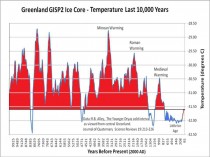
The Roman civilization arose when the earth was much warmer than it’s been recently. And it’s no coincidence that just as the earth was entering the 400-year-long “Little Ice Age,” the Roman Empire was overrun by the Huns. The Egyptians also built the pyramids when it was much warmer than today, and the beginning of the industrial revolution coincided with the end of the Little Ice Age. If global warming is such a problem, doesn’t it seem odd that mankind has always flourished during the earth’s warmest periods?
And if increases in atmospheric CO2 are the primary cause of warming, why, from the 1940’s through the mid 1970’s, was the earth cooling when increases in our use of fossil fuels were at their greatest?

And why is it that Mars and Jupiter, and Neptune’s moon Titan, have all followed the exact same warming and cooling cycles as the earth during the 20th century? Does anyone think that our SUVs and power plants are causing the same climate change on other planets and moons in our solar system, or is it more likely that the changes there were caused by the fact that we’re all in the same solar system? I.e., “It’s the sun, stupid!”
To me, the most worrisome aspect of this problem is that we simply aren’t debating this issue properly.
In 1974, in an article in Time Magazine entitled “Another Ice Age?,” the same alarmists suggested that the (then-)coming ice age was being caused in part by the same vehicular emissions that they’re now blaming for global warming.
Man, too, may be somewhat responsible for the cooling trend. The University of Wisconsin’s Reid A. Bryson and other climatologists suggest that dust and other particles released into the atmosphere as a result of farming and fuel burning may be blocking more and more sunlight from reaching and heating the surface of the earth.
But then it stopped cooling and started warming again. This has been happening throughout history (see Global Warming: Exposing the Far Left’s Lies).
Now, since the warming stopped 12 years ago, the alarmists are finally beginning to admit that the earth has started cooling again. And what are they telling us is the reason why? In what’s got to be one of the most mind-boggling displays of chutzpah ever seen, they’re actually saying that the reason that it hasn’t been warming for the last 12 years is that China and India are now burning such a massive amount of coal, that it blocks the sun’s rays from reaching the earth and warming it. That’s right! Our use of fossil fuels is warming the earth, while China’s is cooling it?
How stupid and gullible do they think we are? Australia just announced that they’re going ahead with a carbon tax on their power companies, rather than a Cap & Trade system. But no matter what they call it, they’re still fleecing the same victims, the people, who’ll be paying this new tax in the form of higher utility bills, and higher prices on everything they buy. And while this insanity unfolds, we’re still paying lip service to this absurd lie by continuing to make reference to the virtues of reducing our “carbon footprint.” Every time we hear that preposterous phrase, we should laugh at it, and then explain why we find it so funny if anyone asks. Years of constant repetition is what sold the lie in the first place. It may take years of constant repetition of the truth to counter it.
Our primary argument against Cap & Trade and the EPA’s CO2 regulations has been that they would be bad for the economy. Of course they would be, but by attacking them on those grounds, we’re granting our sanction to the underlying premise - that CO2 is dangerous. But it’s not. And there never were any benefits to be had from Cap & Trade, regardless of its cost.
There are millions of smart people out there who have been bombarded with this global warming nonsense for so long that they’ve actually come to believe it. The old adage that if you tell a lie often enough it becomes the truth happens to be true, especially when the people don’t get to hear other points of view, something our mainstream media has made sure of over the last few decades.
But even though people are slowly growing skeptical about it, and turning away from the mainstream media, we can’t afford to let our guard down about this scam. And we’ll never truly defeat it for good by arguing against it based on the enormous costs involved. Whether it’s global warming, or global cooling, or ocean acidification, we need to denounce this madness as the outrageous lie that it is, if we’re ever going to defeat this hydra in all of its various guises.
The Inconvenient Skeptic
In the global warming debate there is the idea that for the first time ever the entire Earth is showing warming. In the past there were aberrations where a single part of the Earth would warm up. An hotly debated example of that is the Medieval Warming Period (MWP) where the idea is presented that the warming 1,000 years ago was only around Greenland and Norway while the rest of the Earth was cool. This leads to the idea that what is happening now is unprecedented.
I decided to take a closer look at the modern temperature data for the Earth by different region. I chose the UAH data for this because it has the most data by specific latitude. Using three specific zones it is possible to break the Earth down into three specific regions that are nearly identical in coverage.
Northern (NoExt): 85N to 20N, 166.8 million km2 or 32.7% of the Earth’s surface.
Tropics (Trpcs): 20S to 20N, 174.5 million km2 or 34.2% of the Earth’s surface.
Southern (SoExt): 85S to 20S, 166.8 million km2 or 32.7% of the Earth’s surface.
So between these three zones 99.6% of the Earth’s lower atmosphere is measured. This spatial coverage of the Earth is the best available. The resolution for the satellite data is 4 km2. The end result is that the 508.1 million km2 are equivalently measured by 127 million thermometers evenly spaced 2km apart on a grid that evenly covers 99.6% of the Earth.
Tropics:The tropics are the region that show the least historical climate variability. During the last glacial period the tropics were still tropical. They were warm and the animals living in the rainforests were capable of surviving. It is also the part of the Earth that is the most influenced by the ENSO cycle. El Nino and La Nina are easily detectable in the temperature data from this region.
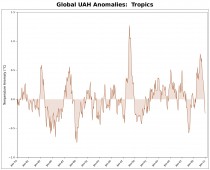
Temperature Anomaly for 20S to 20N from Jan 1979 to May 2011.
Linear regressions can be done of this which would create a trendline that has no meaning whatsoever simply because this is not linear data. This is clearly cyclical data and the cause of that cycle is known to be the ENSO. To be thorough I will show why.
The trendline for the tropics is 0.07 +/- 0.03 C/decade. The R2 for the regression is 0.05. This means that the regression is a very poor model when used to represent the temperature data for the tropics. In fact, that is true for all regions. Smoothing the data (using yearly data instead of monthly data) makes little difference. The data is not linear so treating it that way will ALWAYS be misleading.
A reasonable assessment is there is a lot of variation in the tropical region, but there is no significant trend. There is certainly no statistically significant temperature trend in the Tropics.
Southern:The Southern region covers the Southern Hemisphere from 20S to nearly the South Pole. It covers an identical amount of area that the Northern will. The 32.7% of the Earth’s surface that it covers is only slightly smaller than the Tropics region.
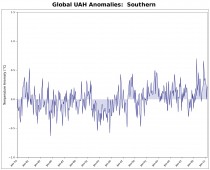
Temperature Anomaly for 20S to 85S from Jan 1979 to May 2011.
Once again a trend could be shown, but the R2 for the regression is 0.10 meaning that only 10% of the data really fits the linear regression model. This is why scientists prefer the R2 value to by much closer to 1 before claiming significance.
The trendline is interestingly enough almost identical to the Tropics though at 0.07 +/- 0.02 C/decade. Note that this trendline by region is less than half the values that are being used by warmists. They typically claim values that are as high as 0.22 C/decade.
When the Earth is viewed in thirds, with 2 of the 3 looked at, the results are very different. For 66.9% of the Earth the rate of warming is nothing like the value claimed by the warmists.
Northern:This leaves us with the region from above 20N to 85N which is the last third of the Earth.
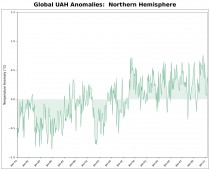
Temperature Anomaly for 20N to 85N from Jan 1979 to May 2011.
Now here is one that shows a difference over the past 30 years. The linear regression for this looks much better as well. The trend works out to 0.27 +/- 0.03C/decade and the R2 is 0.49. Still not great, but not too bad either.
The problem is that the data still isn’t linear. From 1998 to 2010 the trend is no different than the Southern or Tropical regions. What really appears to have happened is a step function change that took place in 1998 where there are two distinct behaviors before and after 1998. The trend over the past 12 years is 0.06 C/decade with an R2 of 0.01. So global warming fully appears to have been a one time event that took place in 1998 and only happened in the Northern region of the Earth.
These results are very bad for the global warming crowd. One of the key claims is that the whole Earth is warming up and that in the past there was only regional variations in climate. That is a key attribute to dismissing things like the Little Ice Age and the Medieval Warming Period.
The modern data is showing that the warming is regional and not steady and certainly not increasing. 1998 really seems like a significant transition year as well. The enormously powerful El Nino that year drove the Tropical temperature anomaly up over 1C for 4 months. That is by far the largest anomaly for large regions of the Earth in the data. That corresponds to the change in temperature in the Northern region.
Keeping that 1998 transition in mind I did the trend for the period up to 1998 and the trend after 1998 by each region.

Trend by region treating 1998 as a dividing line.
The Southern region was showing a cooling trend that matches the magnitude of all the warming trends with the exception of the Northern region in the period from 1979-1998. That is the only warming that appears to be larger than the baseline variation in warming and cooling trends.
If global warming is real and is happening on the global scale. Why does the satellite data fail to detect it? The spatial coverage of the satellite data is unmatched and measures far more of the overall atmosphere than any other method. It isn’t seeing anything of significance that is taking place. The satellite data certainly detects each El Nino and La Nina event. It also detected the transition of the Northern region to a warmer temperature.
The only thing the satellite’s are not detecting is global warming.
Some of the Great Lakes’ treasured national parks are showing ill effects of climate change that are likely to worsen in coming decades, from shoreline erosion to decline of certain wildlife and plant species, a former park system administrator said Wednesday.
Without changes in public policies and personal habits that pump greenhouse gases into the atmosphere, the parks could lose qualities that attract visitors and support unique ecosystems, Stephen Saunders, former deputy assistant secretary of the Interior Department, said a report released by two advocacy groups.
Gainesville “Human disruption of the climate is the greatest threat ever to America’s national parks,” Saunders said. “Threads are being pulled out of the tapestry of these parks and the parks are beginning to lose their luster.”
The Rocky Mountain Climate Organization and the Natural Resources Defense Council helped produce Saunders’ report, which focused on five parks or lakeshores in the region: Indiana Dunes in Indiana; Isle Royale, Sleeping Bear and Pictured Rocks in Michigan; and Apostle Islands in Wisconsin. Together, they drew more than 4 million visitors in 2010.
Using federal temperature data and previous scientific studies, Saunders and colleagues said climate change was at least partially responsible for a series of unfavorable developments in the parks, which can serve as early warning systems for the wider environment. See more of this typical advocacy,don’t bother to check the facts jpournalism here.
A few months ago in testimony to congress we heard similar information from the University of Michigan:
In testimony before the House Energy and Power Subcommittee, University of Michigan’s Knute Nadelhoffer, professor of ecology and environmental biology, said “greenhouse gas emissions from fossil fuels are changing the region’s weather and ecosystem…temperatures have risen 4 degrees Fahrenheit in the northern part of the Great Lakes and 1 degree in the southern region over the past 50 years.”
Lets look at Michigan temperature trends in summer and annual below - even with urbanization, no trend or slight cooling.
Michigan Summer Trends since 1895
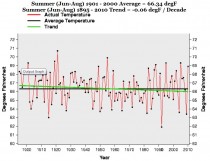
Michigan annual trend
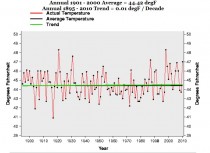
Liars everyone. They never think anybody will ever check the facts. They know their friends in the media can be counted on to believe them. The media is implicated in most of the economic woes we have in this country by backing these government, enviro driven policies driven by greed or ideology.
Rasmussen Reports
One-in-five Americans (20%) say they or someone they know has bought large quantities of traditional light bulbs to use when those bulbs disappear off store shelves next year under new federal light bulb regulations.
A new Rasmussen Reports national telephone survey finds that 70% of Adults aren’t doing that themselves or don’t know anyone who is, but another 10% are not sure.
The new government regulations provide for the manufacture of similar-looking bulbs that will last longer and be more energy-efficient - but also more expensive. Critics view the regulations as unnecessary government intrusion in the free market and see them as effectively banning the kind of light bulb Americans have used for decades.
Just 20% of adults think the sale of traditional light bulbs should be banned. Sixty-seven percent (67%) oppose such a ban. Thirteen percent (13%) are undecided.
However, 57% think it is at least somewhat likely that the new light bulbs, while they will cost more up front, will save money in the long run, as the federal Energy Department claims. Thirty-six percent (36%) think long-term savings are unlikely. These findings include 29% who think the savings are Very Likely and just nine percent (9%) who say they are Not At All Likely.
Two years ago, only 18% of adults thought it was the government’s job to tell Americans what kind of light bulb they should use. Seventy-two percent (72%) say it’s none of the government’s business.
The survey of 1,000 Adults was conducted on July 13-14 2011 by Rasmussen Reports. The margin of sampling error is +/- 3 percentage points with a 95% level of confidence. Field work for all Rasmussen Reports surveys is conducted by Pulse Opinion Research.
Americans have decidedly mixed feelings about the impact of the new fluorescent or halogen bulbs on the environment. Twenty-eight percent (28%) believe the bulbs will be good for the environment, but just as many (28%) think they will be bad environmentally. Twenty-eight percent (28%) more feel they will have no impact. Seventeen percent (17%) aren’t sure.
Still, 81% say they or someone they know has already bought and used one of the new energy-efficient light bulbs.
Perhaps suggesting there may be a consumer surprise coming soon, just 63% of adults have followed even somewhat closely news stories about the legislation mandating the manufacture and sale of only the new high-efficiency light bulbs. This includes only 27% who say they have been following those stories Very Closely.
Women oppose the ‘ban’ on traditional light bulbs more than men do. Voters over 40 are against it more than those who are younger.
But the majority of adults across all demographic categories oppose a ban on the sale of traditional light bulbs, including 69% of those who say they or someone they know has already bought and used one of the new energy-efficient bulbs.
Higher-income voters are the most likely to have already tried out the new bulbs or to know someone who has bought and used one. Those who’ve already used the new bulbs are also much more likely than those who have not to think they will save money in the long run.
Younger Americans are more convinced than their elders that the new bulbs will be good for the environment.
A majority of U.S. voters continue to feel as they have for years that discovering new sources of energy is more important than reducing energy consumption.
Seventy-two percent (72%) of voters believe a free market economy is better than an economy managed by the government. Just 14% think a government-managed economy is better.
By Paul Gregory
Steven Chu was a co-winner of the Nobel Prize in Physics in 1997. That he developed methods to cool and trap atoms with laser light does not mean he understands economics, consumer choice, or politics. A Nobel Prize does not even guarantee common sense. Often it guarantees the opposite.
In a Friday conference call with reporters, Chu argued against a House bill that would repeal a 2007 federal law outlawing incandescent bulbs. Many Americans object to being told that must buy the fluorescent, halogen, and LED bulbs starting in January of 2012 as dictated by federal law.
Chu argued the more-efficient bulbs mandated by Congress save consumers money over the bulb’s life even though the up-front price is higher. Chu defended Congress’s right to dictate what kind of light bulb Americans buy because:
“We’re taking away a choice that continues to let people waste their own money.”
There are many things that cost more up front and “pay for themselves” in terms of longer life or lower operating costs. Think of insulation which costs a bundle but lowers utility bills, or electric cars that costs $10,000 more but save on gas. So far, we have allowed the people themselves to decide: More money now, but less later? Or: Less money now and more later? That is my or your decision.
The choice of light bulb is a classic problem of economic choice over time. Consumers, who place a high value on money now, do not buy insulation, electric cars, or fluorescent lights. We have different time preferences. People who pass on insulation, electric cars and fluorescent light bulbs are by no means wasting their money. They are making choices that are perfectly rational for them.
This basic point of economics escapes Nobel laureate Chu.
Which light bulb is better for you is not an easy calculation. The compact fluorescent costs about six times more and contains hazardous mercury, but lasts six times longer and saves energy. There are also matters of taste and aesthetics. Some will find the new light bulb shape ugly. Others will not like the light it emits, but there will no longer be any choice. Just like we lost Freon in 1995, we will lose Edison’s light bulb in 2012.
Chu says the state should make the choice of light bulbs for you, but why should he stop there? Why not insulation or which car to buy?
Welcome to the Nanny state.
H/T Marc Morano.
By Christopher Booker
Inevitably, when a huge dust storm from the surrounding desert engulfed the city of Phoenix, Arizona, last week, it did not take long for environmentalists to cite it as the kind of “freak weather even” that will become commonplace with “climate change”.
Sceptical blogs, such as Watts Up With That, gleefully responded with pictures going back to the 1950s of similar storms (or “haboobs” as they are known) engulfing Phoenix, on several occasions, and other parts of the West. The EU Referendum blog reproduced, from the Congressional Archive, terrifying images of the storms in the Dust Bowl of the southwestern United States in the 1930s.
One of the more touching features of our global warming zealots is their remarkable ignorance of history. As their religion crumbles, they clutch ever more desperately at any “extreme weather event” to support their sad creed. Hot or cold, dry or wet, droughts, heatwaves, floods or record falls of snow are all inevitably cited as evidence of mankind’s “disruption of the climate” - even if cussed old Mother Nature has produced such things hundreds of times before.
--------------
The Greens Just Love Us to Death
By Alan Caruba
The vote to end the $6 billion in subsidies to ethanol producers reminded me how much Greens love us all. Surely only love could inspire taking corn and turning it into moonshine, and then mixing it with gasoline. The result caused food riots in far off nations while raising the cost of a gallon of gas every time we fill up at the pump. The ethanol mandates actually reduced the mileage a gallon will provide.
At some point, even the Greens grew disenchanted with ethanol and signaled their permission to end this costly boondoggle to our fearless leaders in Washington, D.C.
You may recall they got off to a strong start when the Environmental Protection Agency was established in 1970. Its first act was to ban DDT and the result of that has been the needless death of millions who could and should have been protected against malaria. The nation these days is experiencing a bed bug population explosion that could be stopped in six months if the EPA would only authorize a pesticide to kill the critters. They won’t.
Nor have Greens given up on the Endangered Species Act which has not truly saved any species in the course of spending billions to protect, for example, a spotted owl that needed no protection whatever or gray wolves that were doing quite well in Canada and Mexico when not wandering across our borders. What the ESA did accomplish, however, was to thwart all manner of development, whether it was a new hospital or the irrigation of farms rumored to grow crops people wanted to eat. The latest proposed use of the ESA is to shut down one of the most productive oil reserves in the U.S. to protect a lizard!
These are the same saintly folk who have managed to get a law passed banning the sale of 100 watt incandescent light bulbs in favor of those twisty ones that come with a complete hazmat instruction manual because they contain mercury. The EPA fears mercury so much it is implementing regulations that have already led a utility to announce it is going to close several coal-fired plants rather than spend millions to rid emissions of mercury so small as to constitute no hazard whatever.
When not interfering with the free marketplace, agriculture, timber and other industries, one Green obsession has been energy and, in particular, oil and coal, which they deem “dirty.” Coal is dirty. I used to shovel a bucket or two into the basement furnace until my folks turned to natural gas. The U.S. has billions of cubic feet of natural gas, but you get more mileage from a teaspoon of oil and more electricity from a tablespoon of coal than from any other source of energy.
The U.S. is the virtual Saudi Arabia of coal in terms of the vast reserves known to exist. We have billions of barrels of untapped oil as well. Greens are insanely opposed to both.
Greens are all about not “wasting energy” so naturally that are advocates of two of the least practical ways of producing it, wind and solar energy. Together they comprise less than three percent of the electricity we use in America. In the process, they fill up acres of desert (where lizards and other endangered species live) with solar panels that only work when the sun is shining or defile other acres with huge, ugly wind turbines that chop all manner of birds and bats into confetti while also occasionally catching fire.
The only way to truly “conserve"energy is to not use it and in a nation where everything runs on electricity or gasoline, that means not turning on the lights or driving anywhere. That is a great way to destroy the economy. Getting more mileage from a gallon of gas is another Green fantasy. It has a finite amount, so that translates into making lighter, more dangerous cars.
The Greens have all manner of plans to save America’s forests, swamps, and other areas from the taint of human beings actually having any access to them for any reason. Pretty soon you will have to settle for a stroll in a local park if you want to see a stretch of grass or a bunch of trees. And please do not disturb the Canada Geese, they are a protected species.
The Greens are always fretting about the way members of the horrid human species are destroying the Earth or just endangering it in some fashion. They spent from the late 1980s to the end of the last decade caterwauling about a “global warming” that, in 1998, stopped happening.
Actually, the Earth had begun to warm again around 1850 after three hundred years of what was dubbed a Little Ice Age. Now scientists are warning that, due to a lack of sunspot activity, the Earth is looking to enter yet another Little Ice Age. Some even think we are looking at the big one because we are literally at the end of the 11,500 year cycle between ice ages. The last Ice Age lasted 100,000 years.
In case I didn’t mention it, “global warming:” was a complete hoax, a fraud concocted by the United Nations Intergovernmental Panel on Climate Change in order to gin up a market for the sale and trade of “carbon credits.” Anyone - and I mean anyone - who tells you that humans are causing climate change is a charlatan or a dupe. Avoid them.
My general recommendation is to avoid anything that has the word “green” attached to it. You are being conned into spending more for something than necessary. Learn to love the concept of synthetic. Plastic, a product of petroleum, is synthetic and we use it everywhere for everything. It is one of the greatest inventions of all time.
You cannot “save the Earth.” The Earth is full of volcanoes, tornadoes, forest fires, floods, hurricanes, blizzards, droughts, earthquakes, and other completely natural activities, any or all of which can kill you. It is an utter delusion to think the Earth cares about you even if you care deeply about it.
This is not to say we should not have a profound respect for the Earth and the good sense to marvel at the beauty and majesty of its mountains, oceans, and other manifestations. Just remember to pack a sandwich and bring along a bottle of something to drink if you plan to wander into its “pristine? parts.
IBD Editorial
Environment: The most recent “climate change” news is not about rising sea levels, baking temperatures or an increase in deadly storms. No, the latest news is that the world did not warm between 1998 and 2008.
The study discussed in the editorial above discovered that, although global warming alarmists still claim the sky is burning, Earth’s temperatures did not rise over that 10-year period. In fact, global temperatures actually fell 0.2 degrees Celsius between 2005 and 2008.
In “reconciling anthropogenic climate change with observed temperature,” the Boston University researchers found that despite the “widely noted increase in the warming effects of rising greenhouse gas concentrations,” “global surface temperatures did not rise between 1998 and 2008.”
It’s not clear why, the researchers say. The cooling effect of sulfur emissions, specifically from “large increases in coal consumption in Asia in general, and China in particular,” may be one factor.
But man did not act alone, the researchers say, in causing the temperature to flatline. Natural factors cited in the report include “declining solar insolation and a change from El Nino to La Nina conditions.”
Since it’s impossible to say with any degree of certainty why Earth hasn’t heated as so many predicted it would, we don’t want to debate here any speculation that tries to explain what is responsible for the lack of warming.
We do want to point out, though, that the researchers did acknowledge that the “recent hiatus in warming is driven largely by natural factors.”
What we want readers to remember is this: Our world’s temperature, if such a thing can indeed be accurately measured, has remained steady over a period in which man’s emissions of carbon dioxide, considered by activists to be the top global warming gas, have increased steadily — from roughly 369 parts per million to about 388.
Listen to the Podcast
Subscribe through iTunesGlobal warm-ongers have been on shaky ground for some time, and these recent findings don’t help their cause. True believers such as Al Gore and agenda-driven scientists will continue to talk about the “warmest year ever.” But most of the hot air can be traced to activists yammering to a tuned-out public.
If meteorologist Anthony Watts is right and 2011 ends up being cooler than any year of the last decade, the alarmists’ grip on the public’s attention, and their ability to raise money, will slip even further. This is one way movements die, especially those that had no substance to begin with.
See also Nils Axel Morner’s ARCTIC ENVIRONMENT BY THE MIDDLE OF THIS CENTURY
ABSTRACT:
At around 2040-2050 we will be in a new major Solar Minimum. It is to be expected that we will then have a new “Little Ice Age” over the Arctic and NW Europe. The past Solar Minima were linked to a general speeding-up of the Earth’s rate of rotation. This affected the surface currents and southward penetration of Arctic water in the North Atlantic causing “Little Ice Ages” over northwestern Europe and the Arctic.
Business Green
The European Parliament has today voted against raising the EU’s emission reduction targets, from its current goal of reducing emissions 20 per cent against 1990 levels by 2020, to a 30 per cent cut by the same date.
The vote was initially scheduled for the end of last month, but was delayed until lunchtime today, when MEPs voted 347-258 against the proposal, with 62 abstentions.
The UK, France and Germany had teamed up with a number of other member states to push for the higher target to be adopted, arguing that the impact of the recession on emissions levels meant the more ambitious target could be reached at relatively little additional cost.
Their position was strengthened when the European Commission’s recent Roadmap to 2050 report warned that cuts to emissions of 30 per cent by 2020 would be required if the EU is to meet its longer term goal of an 80 per cent reduction in emissions by the middle of the century.
The report predicted that the 270bn Euros of investment needed to meet the more ambitious goal would be more than offset by 320bn savings in fuel costs and air quality benefits worth up to 88bn a year by 2050.
However, opponents to raising the target, led by Poland which has just taken over the EU presidency, and energy commissioner Günther Oettinger, successfully argued that raising the target when other large economies are yet to sign up to similarly ambitious emission reduction targets would undermine the EU’s competitiveness and encourage many carbon-intensive manufacturing industries to leave the bloc.
The vote will also prove embarrassing to David Cameron, who saw a number of Conservative MEPs defy the prime minister to vote against moving to a 30 per cent target.
The vote represents a major blow to efforts to encourage the EU to deliver more ambitious targets. There had been mooted proposals for a 25 per cent target, but it looks like any change to the 20 per cent goal will be shelved until international climate change negotiations can show that other major economies, such as the US and China, are willing to agree to more ambitious carbon targets.
Green groups expressed dismay at the relatively narrow defeat for the proposal.
“It appears short-term political interest has overtaken long-term public needs when it comes to voting for 30 per cent reductions, said Catherine Pearce of the European Environmental Bureau NGO. “Sadly there are some laggards in the Parliament who still fail to recognise the clear benefits of moving to 30 per cent and the ease of doing so.
“Let us be clear: the case for a move to 30 per cent is stacking up. Large sections of industry, representing millions of jobs, are calling for tougher action - they see the economic advantage to be gained.”


